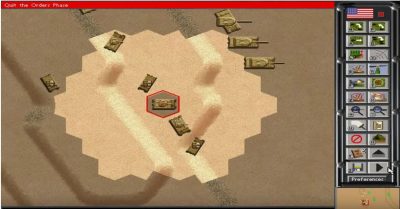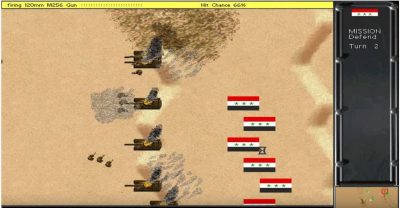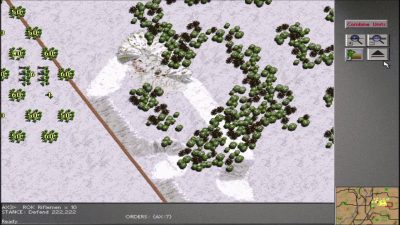Steel Panthers Series Retrospective (Part Two)
By Patrick S. Baker
Steel Panthers II: Modern Battles
 Steel Panthers II: Modern Battles (SPII:MB) was released in November 1996, just one year and two months after the release of the original Steel Panthers (now referred to as Steel Panthers I or SPI). Grigsby had two main goals while developing the new game; one was to improve the animation and the other was to let the players simulate most of the armed conflicts, both major and minor, historical or hypothetical, throughout the world, from 1950 to 1999.
Steel Panthers II: Modern Battles (SPII:MB) was released in November 1996, just one year and two months after the release of the original Steel Panthers (now referred to as Steel Panthers I or SPI). Grigsby had two main goals while developing the new game; one was to improve the animation and the other was to let the players simulate most of the armed conflicts, both major and minor, historical or hypothetical, throughout the world, from 1950 to 1999.
SPII:MB was more than just a reskin of the first game. Grigsby retained the game engine of the original, but the database was completely overhauled with a thousand modern units from 40 different countries, and non-state actors, all modeled in great detail and having characteristics unique to each time period and nationality. For example, helicopters, both scout and attack were added to the weapons inventory and were placed under the players’ direct control.
Airplanes were still in a support mode, but were now equipped with ordinance like precision-guided weapons, napalm, and/or cluster-bombs. Ground forces were kitted out with an assortment of heat-seeking and radar-guided Surface to Air Missiles (SAMs) to counter the air threat, and so on.

The in-game 51 stand-alone scenarios and six campaigns come from many of the major post-World War Two conflicts. A scenario editor was also included, along with the random battle and campaign generator. The new random battle generator allowed the player to create scenarios and whole campaigns on the fly. The player set a number of preferences for such things as the strength of the opposing sides, the time period, the type of terrain, etc. and then launched the scenario. SPII:MB was considered “a major success”. Most of the reviews were generally positive, with one calling it a “a worthy successor to a very successful game”, while noting a number of technical, programing and historical flaws. Computer Games Strategy Plus nominating the game for “1996’s Wargame of the Year”, although it lost to the Battleground games. CNET Gamecenter nominated the game for “Strategy Game of the Year” award, but it lost to Civilization II. Also, Steel Panthers I and Steel Panthers II were collectively named the 62nd best computer game ever, by PC Gamer UK in 1997.
SPII:MB was considered “a major success”. Most of the reviews were generally positive, with one calling it a “a worthy successor to a very successful game”, while noting a number of technical, programing and historical flaws. Computer Games Strategy Plus nominating the game for “1996’s Wargame of the Year”, although it lost to the Battleground games. CNET Gamecenter nominated the game for “Strategy Game of the Year” award, but it lost to Civilization II. Also, Steel Panthers I and Steel Panthers II were collectively named the 62nd best computer game ever, by PC Gamer UK in 1997. Steel Panthers III: Brigade Command 1939–1999
Steel Panthers III: Brigade Command 1939–1999
 Steel Panthers III: Brigade Command (SPIII:BC) was released in November 1997. The game offered the same interface the other games, but was scaled up. The game expanded the scope of the franchise by incorporating larger battles than the first two entries.
Steel Panthers III: Brigade Command (SPIII:BC) was released in November 1997. The game offered the same interface the other games, but was scaled up. The game expanded the scope of the franchise by incorporating larger battles than the first two entries.
Leaders were modeled in depth, and used to spot for artillery and airstrikes, as well as rallying troops. Units were placed in either offensive or defensive modes and given specific terrain goals when on the offense. When units were out of contact with higher headquarters, they carried out their last orders.
Planning ahead became paramount, with the suitable advance orders issued, large parts of the battle could be turned over to computer control. Players could now command up to divisions. Basic units were supersized up to platoons instead of squads and were grouped into larger commands such as companies, battalions and regiments. The game came with six campaigns and 40 individual scenarios, the usual scenario editor and random battle generator. The database held information for 20 World War II nations and 40 post-war nations and non-state actors.
On a note: SPIII:BC was one of the last, maybe the last, major games released strictly in MS-DOS format rather than in both DOS and Windows versions.
Reviews were less glowing for this third game than for the first two entries. Many reviewers noted with disappointment that SPIII:BC was more like an expansion pack, than a fully realized new game. The reviewer for PC Gamer US called it a “a missed opportunity”, but still enjoyed the game. Computer Gaming World said Steel Panthers III was “… not anywhere near the definitive wargaming statements…” made by the first games.
Computer Games Strategy Plus was much more upbeat saying the third game “continues the excellent system begun in the earlier games and builds on that foundation.” CNET Gamecenter continued the positivity, calling Steel Panthers III “one of the best war games running on any operating system” and nominating it for best game in the “Strategy/War” category of 1997.
After the release of Steel Panthers III, Grigsby and Bror contracted to develop games for TalonSoft. So the source code, datebases and title were left with SSI for any future development. But as it happened, SPIII:BC was the last of the games in the series produced by SSI.
Patrick S. Baker is a former US Army Field Artillery officer and retired Department of Defense employee. He has degrees in History, Political Science and Education. He has been writing history, game reviews and science-fiction professionally since 2013. Some of his other work can find some at , and Armchair General.

The biggest change with SP2 was instead of the older 50 unit (49 buyable, 1 HQ) limitation, you now had 150 units (149 buyable, 1 HQ). This made it possible to make complex and detailed scenarios that weren’t armor-heavy clashes (unlike SP1).